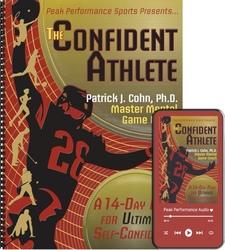
How Confident are you When the Game is in Your Hands?
Confidence is situational. An athlete’s confidence level can vary depending on their situation or circumstances.
That is, you can feel confident in your ability to successfully perform in some circumstances and not others.
For example, a basketball player may feel more confident when shooting free throws early in a basketball game than when on the foul line in the fourth quarter of a tight game…
A gymnast may have more confidence in her ability to nail her routine on the balance beam in a dual meet than when competing in conference championships…
A tennis player may feel more confident closing out a match against a similarly ranked opponent than when competing against a rival…
Why are athletes more confident in some situations rather than others?
Athletes are more confident when they feel comfortable competing in certain situations.
When an athlete is comfortable in their situation, they feel less pressure and anxiety. They are more focused on the task at hand and not distracted by counter-productive thoughts such as, “What if I miss this shot,” “What if I cause my team to lose,” or “What if I mess up and embarrass myself?”
How do you develop confidence and a level of comfort to successfully perform in crucial moments of a competition?
Fear of the unknown creates anxiety. When an athlete is inexperienced in a certain circumstance, they feel uncomfortable and anxious.
You gain comfort by making an unknown known. In other words, the more you expose yourself to pressure situations, the better you will perform in similar circumstances in the future.
Two ways of gaining more experience in competing under pressure are to practice under pressure and visualize yourself successfully performing in critical moments of a competition.
You can practice under pressure by creating pressure scenarios during training sessions, for example, being on the free throw line late in a tied game. You can have your teammates yelling as if you were playing in front of rowdy fans.
You can also visualize specific scenarios in detail, such as “seeing” yourself sinking two free throws late in a game or hitting a buzzer-beater in a playoff game.
Both strategies help you develop a sense of comfort and confidence while competing under pressure.
Take, for example, University of Iowa basketball player Caitlin Clark. Clark nailed a shot from near half-court at the buzzer to help the fourth-ranked Hawkeyes survive an upset against Michigan State.
Clark was confident as she released the ball, not just because she’s a talented shooter.
CLARK: “We practice those plays every single day in practice. That’s what we run every single time: Get Hannah the ball, let me create with some space. They contested it pretty well, honestly, so lucky it went down.”
There is no luck when it comes to performing under pressure. Peak performance under pressure is a trainable mental skill that any athlete can add to their mental game repertoire.
Spend 5-10 minutes each day, practicing under pressure. Make this a fun routine challenge with your teammates after a training session.
Remember, repetition and comfort translates to confidence.
Related Sports Psychology Articles
- How to Build Confidence Like the Pros
- How to Grow Competition Confidence
- How Preparation Boosts Confidence
The Confident Athlete Audio & Workbook

The Confident Athlete Audio & Workbook “The Confident Athlete” teaches athletes how to how to have proactive self-confidence when they step on the playing field, court, track, or course. Available on CD and digital download. For athletes ages 13 and older. Learn how to overcome doubt and other confidence killers. Our most popular program!
“The Confident Athlete” audio and workbook program helps you feel confident before you walk onto the field, track or court. You discover how to have stable and proactive confidence so you can think like a champion.
